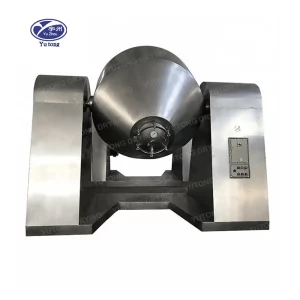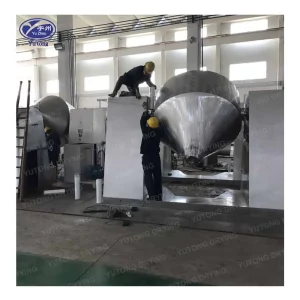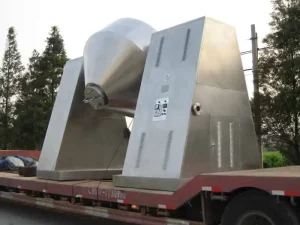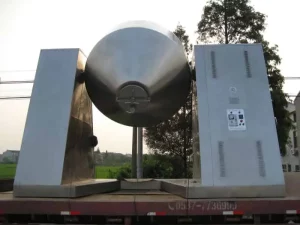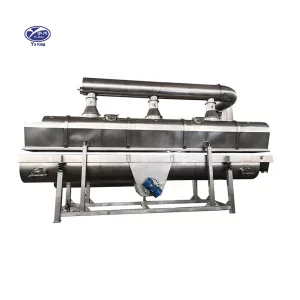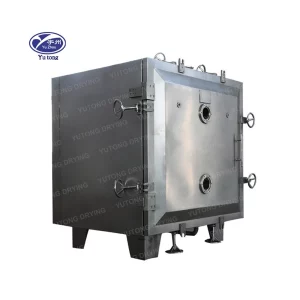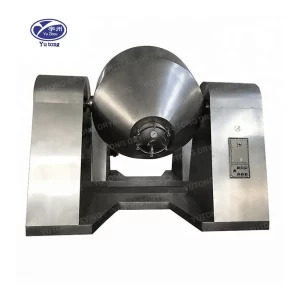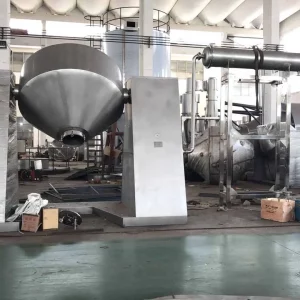Rotary dryers are robust pieces of industrial equipment designed to efficiently remove moisture from bulk materials. They are widely used across various sectors due to their capacity to handle large volumes and their ability to accommodate a broad range of materials. This article provides an in-depth look at how rotary dryers operate, their key components, the industries they serve, and the design considerations involved in their construction.
How Rotary Dryers Work
A rotary dryer consists of a large rotating cylindrical tube through which wet material is fed. The cylinder is slightly inclined to allow gravity to assist in moving the material from the higher end to the lower end. Hot gas, usually air, is passed through the cylinder in the same direction as the material (co-current flow) or in the opposite direction (counter-current flow). The heat from the gas evaporates the moisture from the material, which is then collected as vapor and discharged from the system. The dried material exits the dryer at the lower end.
Key Components of a Rotary Dryer
1. Shell: The cylindrical body made of steel, which contains the material being dried.
2. Lifting Flights: Internal structures that lift and drop the material to increase exposure to the hot gas.
3. Feeding System: Mechanism for introducing wet material into the dryer.
4. Discharge System: Arrangement for collecting and discharging the dried material.
5. Drive Mechanism: Gearbox, motor, and wheels that rotate the shell.
6. Support Structure: Framework that holds the dryer in place.
7. Sealing Systems: To prevent leakage of gases at the ends of the dryer.
8. Dust Collection System: Equipment for capturing dust and particulates from the exhaust gases.
Applications of Rotary Dryers
Rotary dryers find application in a multitude of industries due to their versatility and high throughput capacity. Some key applications include:
1. Mining and Minerals Processing: Drying ores, coal, and aggregates.
2. Agricultural Products: Drying grains, seeds, and biomass.
3. Chemical Processing: Drying chemical intermediates, fertilizers, and salts.
4. Food Processing: Drying food products like cereals, sugar, and coffee beans.
5. Waste Management: Drying sludge and other waste materials for easier disposal or reuse.
Design Considerations
Designing a rotary dryer involves considering several factors to ensure optimal performance:
1. Material Characteristics: Moisture content, particle size, and thermal sensitivity of the material being dried.
2. Heat Source: Type of fuel and burner configuration.
3. Airflow Configuration: Co-current or counter-current flow, which affects the efficiency and uniformity of drying.
4. Size and Capacity: Diameter and length of the dryer, based on the required throughput.
5. Energy Efficiency: Minimizing heat loss and maximizing the use of heat energy.
6. Environmental Impact: Emissions control and dust collection systems to comply with environmental regulations.
Advantages of Rotary Dryers
1. High Capacity: Capable of processing large volumes of material continuously.
2. Flexibility: Can handle a wide variety of materials and moisture contents.
3. Reliability: Robust design ensures long service life with minimal maintenance.
4. Controlled Drying: Allows for precise control over the drying process, ensuring uniform moisture content in the final product.
5. Customizable: Design can be tailored to specific needs, including the choice of heat source and airflow configuration.
Challenges and Limitations
Despite their many advantages, rotary dryers also present some challenges:
1. High Energy Consumption: The process can be energy-intensive, especially for materials with high moisture content.
2. Physical Space: Large units require considerable floor space and height clearance.
3. Maintenance: Regular maintenance is necessary to ensure proper operation and longevity.
4. Cost: Initial investment and operational costs can be significant, especially for larger systems.
Rotary dryers are indispensable in industries requiring the drying of bulk materials on a large scale. Their design flexibility, robustness, and ability to handle diverse materials make them a preferred choice in many applications. As technology advances, improvements in energy efficiency and automation will likely enhance the performance and cost-effectiveness of rotary dryers, making them even more attractive to industries seeking reliable and efficient drying solutions.
What is the difference between a rotary dryer and a spray dryer?
In the field of drying technology, rotary dryers and spray dryers are two commonly used types of equipment. Each has its own unique characteristics and applications. In this article, we will explore the differences between rotary dryers and spray dryers.
Drying is an essential process in many industries, such as food, chemical, pharmaceutical, and mining. The choice of drying equipment depends on various factors, including the nature of the material to be dried, production capacity requirements, energy consumption, and product quality specifications. Rotary dryers and spray dryers are two popular options, but they operate on different principles and have distinct advantages and limitations.
Rotary Dryer
1. Principle of Operation
A rotary dryer consists of a cylindrical shell that is rotated slowly around its axis. The material to be dried is fed into one end of the shell and moves through it under the influence of gravity and the rotation.
Hot air is blown into the dryer, usually from the opposite end of the material feed. The hot air passes through the material bed, transferring heat and evaporating the moisture. The dried material is discharged from the other end of the dryer.
2. Construction and Design
The rotary dryer is typically made of steel and is lined with refractory materials to withstand high temperatures. It may have different configurations, such as direct or indirect heating, depending on the application.
Direct heating rotary dryers use hot combustion gases or flue gases to directly contact the material, while indirect heating rotary dryers use a heat transfer medium, such as steam or hot oil, to heat the shell and indirectly dry the material.
The dryer may be equipped with internal flights or lifters to enhance the drying process by lifting and showering the material, increasing the contact between the material and the hot air.
3. Applications
Rotary dryers are suitable for drying a wide range of materials, including granular, powdery, and lumpy materials. They are commonly used in the drying of minerals, ores, sand, coal, agricultural products, and chemicals.
Due to their large capacity and ability to handle high-moisture materials, rotary dryers are often used in industrial-scale drying operations. They can handle high production volumes and are relatively robust and reliable.
4. Advantages
High capacity and throughput: Rotary dryers can handle large amounts of material, making them suitable for industrial applications.
Versatility: They can dry a wide variety of materials with different moisture contents and physical properties.
Robust construction: Rotary dryers are typically made of sturdy materials and can withstand harsh operating conditions.
Relatively low cost: Compared to some other drying methods, rotary dryers can be cost-effective, especially for large-scale operations.
5. Disadvantages
Longer drying times: The drying process in a rotary dryer can be relatively slow compared to some other methods, especially for materials with high moisture content.
Heat inefficiency: Some heat may be lost due to the large volume of hot air required and the relatively long residence time of the material in the dryer.
Product quality limitations: Rotary dryers may not be suitable for drying materials that are sensitive to heat or require precise control of drying conditions to maintain product quality.
Spray Dryer
1. Principle of Operation
A spray dryer works by atomizing a liquid feed into fine droplets and then contacting these droplets with hot air. The hot air rapidly evaporates the moisture from the droplets, forming dry particles.
The liquid feed is usually pumped through a nozzle or atomizer, which breaks it up into small droplets. The hot air is introduced into the drying chamber, usually at a high velocity, and surrounds the droplets.
As the droplets move through the hot air, the moisture evaporates, and the dried particles are separated from the air stream by means of cyclones, bag filters, or other separation devices.
2. Construction and Design
Spray dryers consist of a drying chamber, atomizer, hot air generator, and separation system. The drying chamber is typically cylindrical or conical in shape and is designed to provide efficient contact between the droplets and the hot air.
Atomizers can be of different types, such as pressure nozzles, rotary atomizers, or two-fluid nozzles. Each type has its own advantages and is suitable for different applications.
The hot air generator can be a gas burner, electric heater, or steam heater, depending on the available energy source.
3. Applications
Spray dryers are widely used in the food, pharmaceutical, chemical, and dairy industries for drying liquid or slurry materials. They are particularly suitable for drying heat-sensitive materials, as the drying process is rapid and the exposure to high temperatures is short.
Examples of materials dried by spray dryers include milk powder, instant coffee, fruit juices, pharmaceuticals, and detergents.
4. Advantages
Rapid drying: The drying process in a spray dryer is very fast, as the small droplets have a large surface area-to-volume ratio, which allows for rapid heat and mass transfer.
Good product quality: Spray drying can produce particles with uniform size and shape, good solubility, and low moisture content. It is suitable for drying heat-sensitive materials without significant degradation.
Versatile feed materials: Spray dryers can handle a wide range of liquid or slurry feeds, including solutions, suspensions, and emulsions.
Compact design: Spray dryers can be relatively compact compared to some other drying methods, especially for high-capacity applications.
5. Disadvantages
High energy consumption: Spray drying requires a large amount of hot air, which can result in high energy consumption. The atomization process also requires energy, especially for high-viscosity feeds.
Equipment complexity: Spray dryers are more complex than some other drying methods, with multiple components such as atomizers, hot air generators, and separation systems. This can increase the initial cost and maintenance requirements.
Product recovery challenges: The separation of the dried particles from the air stream can be challenging, especially for fine particles. Some product may be lost in the exhaust air, reducing the overall yield.
Comparison Summary
1. Drying Principle
Rotary dryers rely on the contact between a material bed and hot air, while spray dryers use atomized droplets and hot air for rapid drying.
Rotary dryers are suitable for drying granular and lumpy materials, while spray dryers are ideal for liquid and slurry feeds.
2. Drying Time and Efficiency
Spray dryers offer faster drying times due to the rapid evaporation of moisture from the small droplets. Rotary dryers may take longer, especially for high-moisture materials.
Spray dryers can be more energy-efficient for some applications, as the short drying time reduces the heat loss. However, rotary dryers may be more suitable for large-scale drying operations with less stringent energy requirements.
3. Product Quality
Spray dryers can produce particles with better quality in terms of uniformity, solubility, and heat sensitivity. Rotary dryers may cause some degradation of heat-sensitive materials and may not provide as uniform a product.
However, rotary dryers can handle a wider range of materials and may be more suitable for materials that are less sensitive to quality variations.
4. Capacity and Scale
Rotary dryers are typically used for large-scale industrial drying operations and can handle high capacities. Spray dryers can also be designed for high-capacity applications, but they may be more suitable for smaller-scale or specialized drying tasks.
5. Equipment Complexity and Cost
Spray dryers are more complex and expensive than rotary dryers due to the additional components such as atomizers and separation systems.
The maintenance requirements of spray dryers can also be higher. However, the cost and complexity may be justified for applications where product quality and rapid drying are crucial.
The choice between a rotary dryer and a spray dryer depends on the specific requirements of the drying process. Rotary dryers are suitable for drying granular and lumpy materials on a large scale, while spray dryers are ideal for liquid and slurry feeds that require rapid drying and good product quality. Considerations such as drying time, energy consumption, product quality, capacity, and cost should be taken into account when selecting the appropriate drying equipment. Understanding the differences between these two types of dryers can help in making an informed decision and optimizing the drying process for a particular application.

